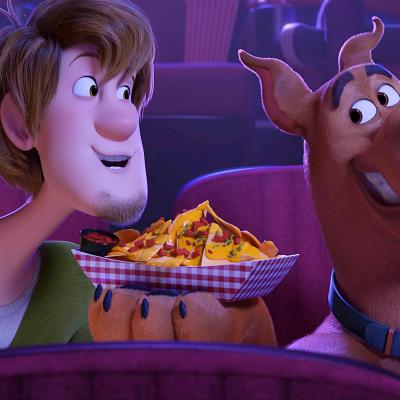Scoob! The Secret Origin of the New Scooby-Doo Movie
The creators of the new Scooby-Doo movie share their years-long journey to Scoob!

This interview contains very mild character spoilers for Scoob!
Like many of us, Scoob! animation coordinator Bill Haller’s first memories of Scooby-Doo center around the long-lost Saturday morning lineup.
“I grew up with Scooby-Doo as part of Saturday morning cartoons. Me and my sister sitting in front of the TV and arguing over what lineup we were going to do. I don’t even know if they have lineups like that anymore?” Heller laughs.
Those warm recollections shaped the director’s childhood, which made taking on Scoob!, the new Scooby-Doo movie from Warner Bros., an incredibly special experience. “Scooby-Doo and Hanna-Barbera were such a big part of growing up for me and my sister. It kind of engrossed our culture. So, honestly, to be involved with a project like this one is a real honor along with a responsibility to pay homage and do it right.”
Director Tony Cervone was another early adopter of the classic cartoon series.
“I think I was watching Scooby-Doo right from the beginning, “Cervone says. “I remember really loving the guest stars, wondering who was going to appear. It was Don Knotts one week, and then Mama Cass or Laurel and Hardy. I remember thinking, ‘I want to live in a world where this could happen!'” And in a way, helming Scoob! has allowed Cervone to achieve that childhood dream, playing in a vast, immersive world that features many of the most iconic Hanna-Barbera characters.
The animated adventure centers around Scooby-Doo (Frank Welker) and Shaggy (Will Forte), alongside their usual cohorts Fred (Zac Efron), Daphne (Amanda Seyfried), and Velma (Gina Rodriguez). When the beautifully rendered animated character designs for Scoob! were first released, the internet went absolutely wild. So how did they get to the final versions that we see on screen?
“It wasn’t so much redesigning the characters as looking at the original model sheets,” Heller says. “We literally went back to the original 1969 model sheets, through Tony’s direction, and tried to try to do that in 3D.”
It took Heller and Cervone five years to land on the right balance between the modern and the original.
“The things that worked, we used, and the things that didn’t work, we tried to alter to still capture the spirit of it,” Heller says. “We went down some roads that unfortunately we had to go down to realize where we needed to be going. And it always seemed to circle back to those original 1969 designs.”
Though they finally settled on an aesthetic that leaned into the original designs, it wasn’t always going to be that way.
“That’s the one thing that I think people won’t realize, how many different things we did along the way,” Cervone says. “This movie was years in the making. And we built many Scooby-Doos, some that look much more like real dogs, some that were very design-y…But at the end of the day, we just kind of went all the way around the world and came back to how we make the most faithful 3D representation of Scooby that we can. But by doing that, by doing all that exploration, it really helped create the final character. It’s important to do that, to throw things away and keep working, because even if you throw things away you still learn something. But we didn’t really throw anything away, it just sort of evolved.”
Once the team had settled on the visual tone and language of the movie, they had another challenge. How to bring a 2D world and its 2D cast of characters to a super-high-definition 3D landscape? The answer: trial and error…lots of it.
“Scooby-Doo was designed to work 2D, so we had to explore multiple different angles that we knew that we were going to see in the film,” Heller says. “How’s that going to work? Are we going to have to hide those angles? So we did a lot of testing early on, we just did turntables of him doing various things, just to see what he looks like from all angles.”
Even getting Scooby’s walk right was a journey for the team.
“I remember there was a time we did a test because we were trying to crack his traditional walk,” Heller says. “And we did a test of him walking across the beach and then up a hill, and you saw his backside. And I don’t know if we’ve ever seen his backside before when he’s walking in this traditional way. So we were like, ‘Well, can we hide him with Shaggy going past?’ There was a lot of trying to find solutions where we had to solve those types of things.”
Of course, they also had to work out how these characters work in a modern context. Luckily, Cervone’s experience on Scooby: Doo: Mystery Incorporated gave him experience in how to deal with one of the most iconic and mystifying parts of Scooby-Doo: Fred’s bright red ascot.
“The visual design of that show was almost dominated by Fred’s Ascot,” the director laughs. “We wanted him to have it but we’re like, ‘How do we create a world where it’s normal for this guy to be walking around with this thing on?’ So we went and bought every clothing catalog we could from ’68, ’69, and ’70. Every costume in that entire series comes out of one of those catalogs. We were able to look at those three years of fashion and realized there was like three months when young men wore ascots and that was when Fred was designed.”
That vital bit of costume has a hilarious moment in Scoob! which will relieve fans who were dismayed at not seeing the ascot in the trailers for the film. “When the trailer came out I was getting a lot of messages like, ‘Where is it? This is sacrilege.’ And I was like, ‘Do you think I’d forget it?’ Like after all these years do you think it wouldn’t make an appearance??”
Heller chimes in, “So many animators wanted to animate that shot of the ascot, there were so many requests for it.”
Scoob! takes the grand tradition of Hanna-Barbera crossovers and uses it to build what feels like the first entry in what could be a new cinematic universe. And according to Cervone, that’s exactly what they were going for.
“I do feel like this Hanna-Barbera universe is kind of a separate universe and acts as its own thing,” Cervone says. “So we were able to be like, ‘We’re gonna create an alternate universe where all these things can happen.’ That gave us some liberty, but we tried really hard to maintain the things that we already love about the characters, and then do more because you have to do both. You have to honor the past and honor our collective memory while also having to do something new.”
So could we see a Hanna-Barbera expanded universe? The credits of the film certainly hint that there’s plenty more story to be told.
“There’s so many ways you could go,” Heller says. “I kind of want to spend more time with those kids and tell those early stories. I love Captain Caveman, I think that guy could have his own movie. I think Brian, Dynomutt, and Dee Dee could have their own series. I want to see more of the Falcon Force. I want to watch that team grow because there’s definitely, even in the credits at the end, you could see that the team is growing. This franchise that has been around for 50 years and my hope is that it will still be going in 50 years from now and in 100 years someone will be making a new Scooby-Doo movie.”
Cervone agrees. “We all carry that baton for a while and then we pass it on to someone else. I feel like now there’s this new playground for people to play in. Get in there and go for it, you know? The classic world still exists and now we’ve got this other world, go mess with it!”
You can watch Scoob! on Video on Demand services from May 15th!

